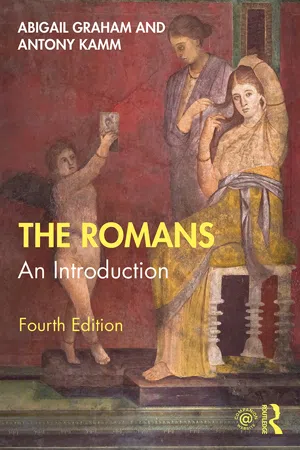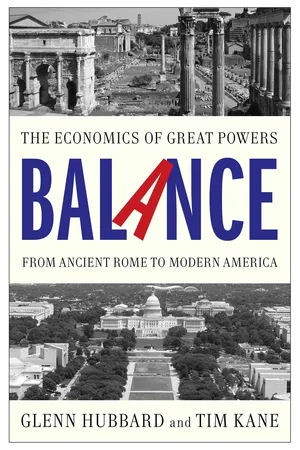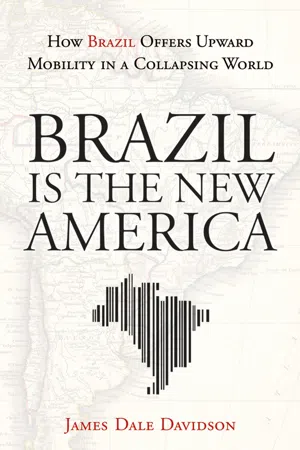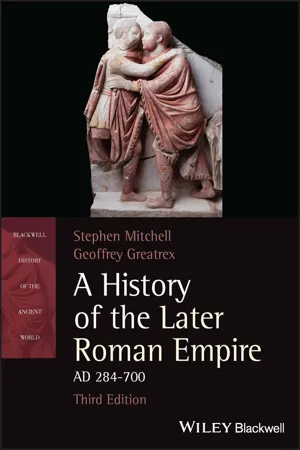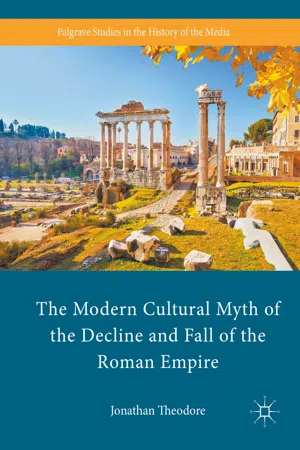History
Fall of Roman Empire
The fall of the Roman Empire refers to the decline and eventual collapse of the Roman state in the 5th century AD. It was marked by a combination of internal and external factors, including political instability, economic troubles, invasions by barbarian tribes, and the division of the empire into eastern and western halves. The fall had far-reaching consequences for the Western world, leading to the onset of the Middle Ages.
Written by Perlego with AI-assistance
Related key terms
7 Key excerpts on "Fall of Roman Empire"
- eBook - ePub
The Romans
An Introduction
- Abigail Graham, Antony Kamm(Authors)
- 2020(Publication Date)
- Routledge(Publisher)
11 The fall of the Roman Empire and its legacy: ad 330-PresentSome of the evidence (authors, events, historical figures and materials) discussed in this work are subjects of case studies on an accompanying webpage for this book. Look out for the companion website symbol.The decline of Rome was the natural and inevitable effect of immoderate greatness. Prosperity ripened to the principle of decay; the causes of destruction multiplied with the extent of conquest; and as soon as time or accident had removed artificial supports, the stupendous fabric yielded to the pressure of its own weight.(E. Gibbon, The History of the Decline and Fall of the Roman Empire (1776), chapter 38)The traditional ideologies and historical framework which the early emperors of Rome sought to institutionalize in the city’s monumental buildings became a liability in a new Christian world, where pagan traditions were not immediately reconciled with Christian values. That Rome retained her pagan values is attested not only in the number of Christian churches which remained outside the city walls until the 5th century, but also the pagan games and festivals, many of which continued through the 5th century ad (the final Lupercalia festival, for example, was recorded ca. ad 494), when Pope Gelasisus criticized a Roman senator for “streaking about” in the buff. The historian Ammianus Marcellinus, who lived in Rome in the 4th century and fought as a soldier, captures this fluctuating world, struggling at times to reconcile the prejudices of Christians and pagans alike. Although Ammianus’ manuscript only survives as a fragmented codex from ad 353–78, it reveals a flame of traditional Roman culture as it flickers into oblivion, or as Gibbon would suggest: collapses upon itself.The fall of Rome ad 330–476Constantine had intended that, upon his death, the rule of the Empire should devolve to a team of four: his three sons, Constantine II (ca. 316–40), Constantius II (317–61) and Constans (ca. 322–50), and his nephew Dalmatius. To form a tetrarchy on a dynastic principle was, however, more than the system could stand. Dalmatius was murdered, the brothers bickered, their armies fought and the Empire was in splinters once again. The failure of dynasty was a lesson Rome’s leaders would never learn, to her great peril. - eBook - ePub
Balance
The Economics of Great Powers from Ancient Rome to Modern America
- Glenn Hubbard, Tim Kane(Authors)
- 2013(Publication Date)
- Simon & Schuster(Publisher)
11EVIDENCE OF THE FALL
There remains a popular theory that the emergence of Christianity during the later empire was a principal cause of Rome’s fall. This explanation was prominent in Edward Gibbon’s famous History of the Decline and Fall of the Roman Empire, published in 1776. Today, that theory has been largely debunked. “Most scholars have considered economic forces as critical,” wrote Nobel laureate Douglass North in Structure .One fashionable modern theory that grabs attention is this: Rome never fell. Forget searching for causes, these historians say. Rather, migratory pressures led to a gentle evolution of the culture. What’s so great about empire, anyway? Historian Bryan Ward-Perkins made a definitive case for the traditional, politically incorrect viewpoint in his 2005 book, The Fall of Rome:It is currently deeply unfashionable to state that anything like a “crisis” or a “decline” occurred at the end of the Roman Empire, let alone that “civilization” collapsed and a “dark age” ensued. The new orthodoxy is that the Roman world, in both East and West, was slowly, and essentially painlessly, “transformed” into a medieval form. However, there is an insuperable problem with this new view: it does not fit the mass of archaeological evidence now available, which shows a startling decline in the western standards of living during the fifth to seventh centuries. This was a change that affected everyone, from peasants to kings, even the bodies of the saints resting in their churches. It was no mere transformation—it was decline on a scale that can reasonably be described as “the end of a civilization.”Ward-Perkins effectively traces the loss of complexity to a collapse of the scale of Rome’s once vast, once frictionless, internal trade market. Without scale, specialization dried up. Whole towns died, and whole regions reverted to lower levels of development than they had been at before - eBook - ePub
Brazil Is the New America
How Brazil Offers Upward Mobility in a Collapsing World
- James Dale Davidson(Author)
- 2012(Publication Date)
- Wiley(Publisher)
As the private wealth of the Empire was gradually confiscated or taxed away, driven away or hidden, economic growth slowed to a virtual standstill. Moreover, once the wealthy were no longer able to pay the state’s bills, the burden inexorably fell onto the lower classes, so that average people suffered as well from the deteriorating economic conditions. In Rostovtzeff’s words, “The heavier the pressure of the state on the upper classes, the more intolerable became the condition of the lower classes.” (Rostovtzeff 1957: 430). . . .Although the fall of Rome appears as a cataclysmic event in history, for the bulk of Roman citizens it had little impact on their way of life. As Henri Pirenne (1939: 33-62) has pointed out, once the invaders effectively had displaced the Roman government they settled into governing themselves. At this point, they no longer had any incentive to pillage, but rather sought to provide peace and stability in the areas they controlled. After all, the wealthier their subjects the greater their taxpaying capacity. . . .In conclusion, the fall of Rome was fundamentally due to economic deterioration resulting from excessive taxation, inflation, and over-regulation. Higher and higher taxes failed to raise additional revenues because wealthier taxpayers could evade such taxes while the middle class—and its taxpaying capacity—were exterminated. Although the final demise of the Roman Empire in the West (its Eastern half continued on as the Byzantine Empire) was an event of great historical importance, for most Romans it was a relief.10Of course, the United States is not going to be pillaged by Germanic tribes. But what you can expect, as suggested in the passage quoted from the Cambridge Ancient History , volume 11, is a Roman-style response as “the menace of state bankruptcy” draws nearer.11You will see a replay of “the fierce endeavor of the State to squeeze the population to the last drop.” The amount of squeezing will be prodigious as the United States is well and truly insolvent. The first danger is that taxes will be raised to confiscatory levels—on the wealthy.Like the original Alternative Minimum Tax, the new, higher rates will apply at first only to a small segment of the population. But as the continued emissions of new dollars conjured out of thin air inevitably devalue the currency, the price level will skyrocket, and you will end up earning, millions or even hundreds of millions of dollars, making you one of the “wealthy” to whom the new “taxes on the rich” will apply. - eBook - ePub
- Stephen Mitchell, Geoffrey Greatrex(Authors)
- 2023(Publication Date)
- Wiley-Blackwell(Publisher)
During the 630s the state proved unable to repel or neutralize the unexpected challenge of the Arabs, who came from an area of the empire that had previously been both metaphorically and literally marginal and had never previously posed a major threat. The arguments in this chapter suggest that the central cause of this collapse was not exhaustion caused by the twenty-year struggle with the rival empire of the Sasanians, but an acute demographic – and therefore economic – recession caused by the plague across the regions of Europe, the Mediterranean, and the Near East. By the beginning of the seventh century Rome could neither summon nor deploy the resources necessary for sustained military or diplomatic efforts against determined enemies. The implosion of the Roman state as a viable world power had been matched by internal cultural and social changes. Throughout late antiquity the empire had been transformed by the changing role and nature of Christianity within Roman society, and the symptoms of this, which have been extensively discussed and analyzed in modern scholarship, were especially apparent in the sixth and seventh centuries. They include the emergence of bishops as community leaders, who became dominant figures in secular as well as religious matters, 88 and the growing importance of Christian asceticism, which underpinned the influence of charismatic individual saints, 89 and even more importantly led to the creation of the monastic movement (see pp - Jonathan Theodore(Author)
- 2016(Publication Date)
- Palgrave Macmillan(Publisher)
what his theory of the decline and fall constitutes therefore warrants considerable attention.Before Gibbon, the chief emphasis in much Late Antique and Medieval historiography had been on the translatio imperii , the “transfer of rule,” or the passing on of the heart of civilization: from pagan to Christian Rome, and from pax Romana to Charlemagne and the Holy Roman Empire of the Middle Ages.35In this philosophy, Roman history and culture had changed, developed, even declined from its highs; but it did not necessarily collapse into oblivion and ruin. A variation on this idea for the Eastern Empire is found in the “Third Rome” myth: namely, that after the collapse of the Byzantine Empire, the Muscovite Tsars supposedly took over the mantle as the inheritors, not just of Orthodox Christianity, but of the entire East Roman tradition—a burden seamlessly passed on to the Russian Empire, the (formally atheist) Soviet Union and subsequently even to the Russian Federation.”36Gibbon, however, initiated a new phase in the moralizing, didactic interpretation of the Roman Empire and its fate. It is in his writing that the decline and fall myth emerges in its consolidated, coherent form—and one with a clearly comparative purpose. In the Decline and Fall of the Roman Empire he wrote a prose epic, one in which the panorama of historical experience is viewed on a universal, yet highly subjective scale. The title of his work reflects the concerns of the time: it is less a work of “history” in the narrow or descriptive sense than a broad treatise on human nature, its triumphs and failings, and highly notable for how much it is indicative of contemporary concerns, rather than the remote past it describes.37- eBook - ePub
Britain's Imperial Muse
The Classics, Imperialism, and the Indian Empire, 1784-1914
- C. Hagerman(Author)
- 2013(Publication Date)
- Palgrave Macmillan(Publisher)
6 Classical Discourse and the Decline and Fall of Empires Toward the end of his History of the Decline and Fall of the Roman Empire, Gibbon confidently opined that ‘attention will be excited by an history of the decline and fall of the Roman empire; the greatest, perhaps, and most awful scene, in the history of mankind.’ 450 This was not a hopeful fantasy. His immensely popular opus became a historical classic before his eyes and stood as a key element in understandings of empire in antiquity from the publication of the first volume in 1776, through the remainder of our period. As we have seen, while he said a great deal on the positive side, particularly with respect to the peace and prosperity of Rome’s golden age and the civilization spread via Rome’s imperial conquests, decline and fall was of course Gibbon’s central theme. Like the other imperial elements of classical discourse, the narrative of imperial decline originated in familiar ancient sources. Sallust and St Augustine spoke explicitly of Rome’s decline; Thucydides and Xenophon wrote of Athens’ imperial ruin; Arrian addressed the corrosive effect of imperial success on Alexander’s character. 451 Though working in differing periods and on distinct historical episodes these ancient authorities all agreed that in one way or another imperial success ultimately led to decline. Unsurprisingly then, Gibbon was hardly the first student of ancient history to put the question or offer an answer. Montesquieu and Hume preceded him by forty years and Machiavelli by nearly three centuries. 452 It just so happened that Gibbon’s treatment of the issue largely superseded those of his predecessors and became a starting point (and often the last word) for generations to follow, thanks to its style, scope, and historical situation - eBook - ePub
Western Civilization: A Global and Comparative Approach
Volume I: To 1715
- Kenneth L. Campbell(Author)
- 2014(Publication Date)
- Routledge(Publisher)
It was up to Constantine to demonstrate the compatibility between Christianity and the Roman political order. Although he did not officially convert to the Christian faith until he was on his deathbed, he, along with his co-ruler, Licinius, had issued an Edict of Toleration in 313 and generally favored the church during his reign. He may have waited so long to be baptized simply so that he would not die in a state of sin. He proclaimed the Christian Sabbath a weekly holy day, naming it Sunday—perhaps to appease those who were still pagan or perhaps partly out of his own sun worship, which he may have conflated with his new religion. Constantine sought to unify the faith by summoning more than 300 bishops to meet at a council at the city of Nicaea, where in 325 they agreed on a creed that summarized the orthodox doctrines of Christianity. Constantine’s conversion and practice of toleration naturally smoothed the path for millions of new converts. The numbers of Christians in the empire expanded exponentially during the fourth century. Christians went from potential antagonists of the imperial regime to its greatest supporters. But when Rome fell less than 100 years later, there were still those who placed the blame upon the Christians.The Fall of Rome
Several different dates have been suggested for the fall of the western half of the Roman Empire. Some historians view the Roman defeat at the hands of the Goths at the Battle of Hadrianoplis (modern Edirne) in 378 as a decisive turning point. But others observe that the system of administration set up by Constantine remained intact and that the emperor Theodosius I (r. 379–395) negotiated a peace settlement with the Goths in 382. The sack of Rome itself by the Visigoths in 410 was seen by the Romans as an event of great importance. But the Visigoths moved on from Rome, eventually settling in Spain, with imperial authority continuing in the West for two more generations. For many, 476 marks the traditional date of the fall of Rome, for in that year the sixteen-year-old Romulus Augustulus (r. 475–476), the last Roman emperor in the West, was deposed and imperial authority officially ended. But by then effective imperial authority had already collapsed. The deposition of the last emperor in the West in 476 seems more an act of recognition rather than a decisive, history-altering event. The great Belgian historian Henri Pirenne (1862–1935) even made the case that imperial authority continued in the West after this date, having simply passed on to barbarian rulers who at least formally recognized the legitimate power of the eastern emperors, and only disappeared as a result of the Muslim invasion of the seventh and eighth centuries.
Index pages curate the most relevant extracts from our library of academic textbooks. They’ve been created using an in-house natural language model (NLM), each adding context and meaning to key research topics.
